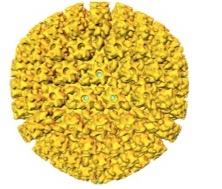Herpes-infected rhesus macaque monkeys have been in the news because there is a group of them in the Silver Spring, FL area which is growing. And in the process of growing, they are also infecting each other. About 30% of the macaques are now infected with herpes. But the pathogen is not the "every day" herpes we all know about. It's a very different herpesvirus (1) called herpes B or monkey B virus (BV) and it's nothing to monkey around with.
It is deadly to humans; 80% of people who contract BV will die without treatment with acyclovir/Valtrex (2). But transmission from macaques, which are largely asymptomatic, to humans is extremely rare. There have been only a few dozen confirmed deaths since 1933. So, there is very little to worry about, despite the fact that the Department of Justice has classified the virus as a potential terrorism agent.
What's most interesting is the virus itself. The reasons why monkey herpes is so deadly is because of both the similarities and differences with human herpes. We get the worst of both worlds.

(Left) HSV-1. (Right) BV. The difference in color is not relevant. Source: Virus World
HOW VIRUSES WORK
Most viruses have similar modes of action.
- Viral spikes bind to a specific receptor on the surface membrane of a particular host cell (Attachment)
- The virus "dissolves" the membrane to gain entry into the cell. (Entry/fusion)
- The virus breaks open, releasing its DNA/RNA plus the viral enzymes necessary for replication.
- Viral DNA/RNA enters the cell nucleus.
- The genetic material hijacks the cell's DNA/RNA, tricking the cell into manufacturing viral DNA/RNA. (Replication)
- Viral enzymes perform the steps necessary to make many new virus particles. (Assembly)
- The new virions break through the cell membrane. (Release)
- The "progeny viruses" infect other host cells. (2)
SIMILARITIES
Herpes B behaves very much like herpes simplex virus (HSV). Both viruses follow the entry-replication-assembly-release pathway. The rate of cell infection, DNA synthesis, and They each bind to a specific cellular receptor, and they can both be treated with the antiviral drug acyclovir, however, the drug is much less effective against B than HSV. Both viruses attack mucous membranes or can enter the blood through broken skin. Like other herpes viruses both establish latency in the hosts. And the genome of BV is very similar in size to that of HSV; BV has 162,000 base pairs, HSV-2 has 155,000. Both genomes consist of double-stranded DNA. Let's call them "mid-sized."(3)
But there is one difference and it is critical.
DIFFERENCES
Given the similarity of the human and simian forms, one might expect a similar outcome upon infection. But this is not at all the case; herpes B goes after the human central nervous system (CNS), specifically the upper spinal cord and lower brain. This is why it is deadly to people.
Clinical observations support CNS involvement. Patients develop flu-like symptoms and numbness at the site of infection. As the infection progresses severe inflammation of the spinal cord ascends toward the brain. At that point you are toast. Death usually occurs due to respiratory failure. Not a nice way to go.
Viruses are beyond fascinating. Our bodies are swarming with them, but most do no harm. While a virus may be benign in one species it can be deadly in another (HIV came from chimps). They have "figured out" (evolved, really) how to replicate by carrying the bare minimum of proteins and genetic material into host cells and completely taking over the cell. Viruses have been called "bags of chemicals;" this is not inaccurate. And it is all but certain that the list of cancers caused by viruses will continue to grow and they will be implicated in other poorly-understood diseases, such as Alzheimer's, Type 1 diabetes, and other autoimmune diseases.
Not bad for a bag of chemicals.
NOTES:
(1) Yes, this is one word.
(2) This is very simplified. In reality, there is much more going on, but the same basic steps are followed.
(3) Virus genome size has a huge range. The smallest is circoviruses (2,000 base pairs). The largest is Pandoraviruses (2.5 million). A base pair consists of one of the four nucleic acid bases on one strand and its complementary partner on the other strand. There are four, cytosine (C), guanine (G), adenine (A), and thymine (T). In DNA cytosine always pairs with guanine, and adenine with thymine. This is governed by very simple organic chemistry - the size of the molecule and arrangement of the nitrogen atoms. For a reasonable fee I will happily demonstrate this ;)




